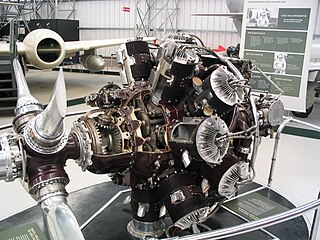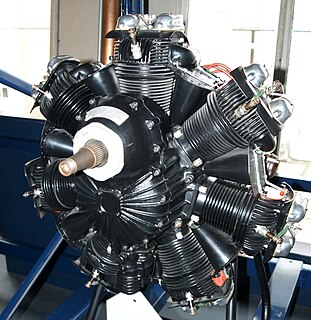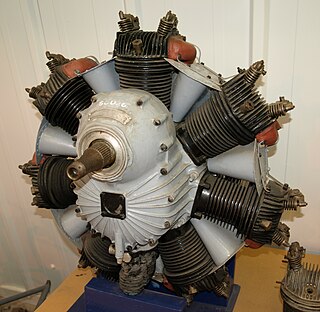
The Bristol Jupiter was a British nine-cylinder single-row piston radial engine built by the Bristol Aeroplane Company. Originally designed late in World War I and known as the Cosmos Jupiter, a lengthy series of upgrades and developments turned it into one of the finest engines of its era.

The Bristol Pegasus is a British nine-cylinder, single-row, air-cooled radial aero engine. Designed by Roy Fedden of the Bristol Aeroplane Company, it was used to power both civil and military aircraft of the 1930s and 1940s. Developed from the earlier Mercury and Jupiter engines, later variants could produce 1,000 horsepower (750 kW) from its capacity of 1,750 cubic inches by use of a geared supercharger.

The Bristol Perseus was a British nine-cylinder, single-row, air-cooled radial aircraft engine produced by the Bristol Engine Company starting in 1932. It was the first production sleeve valve aero engine.

The Bristol Hercules was a 14-cylinder two-row radial aircraft engine designed by Sir Roy Fedden and produced by the Bristol Engine Company starting in 1939. It was the most numerous of their single sleeve valve designs, powering many aircraft in the mid-World War II timeframe.
Cosmos Engineering was a company that manufactured aero-engines in a factory in Fishponds, Bristol during World War I. Sir Roy Fedden, the company's principal designer, developed the 14-cylinder radial Mercury engine during this period. The company was taken over by the Bristol Aeroplane Company in 1920.

The Armstrong Siddeley Jaguar was an aircraft engine developed by Armstrong Siddeley. The Jaguar was a petrol-fuelled air-cooled 14-cylinder two-row radial engine design. The Jaguar III was first used in 1923, followed in 1925 by the Jaguar IV and in 1927 by the Jaguar VI. In 1925 the Jaguar became the first production aero engine incorporating a geared supercharger.

The Armstrong Siddeley Mongoose is a British five-cylinder radial aero engine produced by Armstrong Siddeley. Developed in the mid-1920s it was used in the Hawker Tomtit trainer and Parnall Peto seaplane amongst others. With a displacement of 540 cubic inches (9 litres) the Mongoose had a maximum power output of 155 horsepower (115 kilowatts).
The Bristol Hydra was an experimental 16-cylinder, twin-row radial aircraft engine built by the Bristol Engine Company. It is a relatively rare example of a radial with an even number of cylinders per row – it is often claimed that radial engines require an odd number of cylinders, but this is simply easier, not physically required. Only two Hydras were built, the type never entered production.

The Short S.16 Scion and Scion II were 1930s British two-engine, cantilever monoplanes built by Short Brothers and by Pobjoy Airmotors and Aircraft Ltd. in Rochester, Kent between 1933 and 1937. Altogether 22 Scion/Scion II aircraft were built and they provided useful service to operators working from small airstrips/water courses in many parts of the globe, including Europe, the Near and Middle East, Sierra Leone, Papua New Guinea and Australia. Many were impressed into the Royal Air Force during the Second World War, providing pilot ferry services, anti-aircraft co-operation and radar calibration duties. Of the civilian Scions, at least two were still operating in Australia in 1966, one having been re-engined with de Havilland Gipsy Minor engines.

The Pobjoy Niagara is a British seven-cylinder, air-cooled, radial, aero-engine first produced in 1934. The design ran at higher speeds than conventional engines, and used reduction gearing to lower the speed of the propeller. This led to a noticeable off-centre mounting for the propeller. The Niagara was a popular engine for light and experimental aircraft, well regarded due to its small diameter, smooth operation, low noise and innovative engineering.

The Pobjoy R is a British seven-cylinder, radial, air-cooled, aircraft engine designed and built by Pobjoy Airmotors. Introduced in 1926 it was a popular engine for ultralight and small aircraft in the 1930s. A notable feature of the Pobjoy R was the propeller reduction gear which allowed the small engine to operate at more desirable higher speeds.

The Blackburne Thrush was a 1,500 cc three-cylinder radial aero-engine for light aircraft produced by Burney and Blackburne Limited. Burney and Blackburne were based at Bookham, Surrey, England and was a former motorcycle manufacturer.

The Bristol Neptune was a seven-cylinder air-cooled radial engine developed in 1930. It had the same size cylinders as the earlier Mercury and Titan engines, 5.75 in (146 mm) x 6.5 in (165 mm) which gave a displacement of 1,182 cu in and produced a maximum of 320 horsepower (239 kW). The Neptune was effectively a seven-cylinder version of the Titan.
The Comper Kite was a single-engined, two-seat touring monoplane built in the UK, derived from the contemporary Comper Streak racer. Only one was built.
The Pobjoy Pirate was a three-seat, high-wing monoplane designed to compete with the de Havilland Leopard Moth using a low power but light Pobjoy radial engine. Flight tests showed the Pirate to be uncompetitive and its development was rapidly abandoned.

British Salmson aero-engines refers to a series of small French designed, air-cooled radial aero engine that were produced by British Salmson, under license from Société des Moteurs Salmson, in Great Britain during the late 1920s and 1930s.

The Nicholas-Beazley Pobjoy Special aka the Nicholas-Beazley Phantom I, aka the Wittman Phantom, aka the Flagg Phantom, aka the Reaver Special was a world record holding air racer of the 1930s
The Gribovsky G-25 was a Russian tandem seat biplane basic trainer built in the late 1930s. It was hoped to minimize unit costs by using a modified automobile engine but the G-25 did not reach production.
The Pobjoy P was a British seven-cylinder, air-cooled, aircraft engine designed by Douglas Rudolf Pobjoy and built by Pobjoy Airmotors. It became the progenitor of the Pobjoy R/Niagara/Cataract family of small radial engines. A notable feature of the Pobjoy P was the propeller reduction gear which allowed the small engine to operate at more desirable higher speeds.
The Cierva C.25 was a British 1930s single-seat autogiro produced by Comper Aircraft Company Ltd of Hooton Park, Cheshire.













